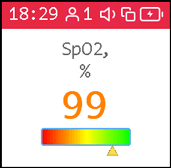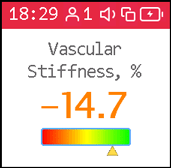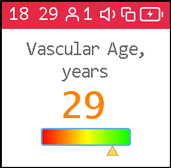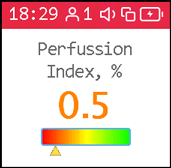Measured Parameters
- Pulse rate;
- Hemoglobin oxygen saturation;
- Perfusion index (PI);
- Vascular age;
- Vascular stiffness;
- Pulse wave type;
- Relative duration of systole;
- Stress level.
For each parameter, the device displays the numerical value and its evaluation in the chart with color-coded ranges. Color-coded ranges correspond to the following qualitative assessment results:
- green – good condition;
- yellow – satisfactory condition; increased risk of functional disorders, including cardiovascular;
- red – poor condition; high risk of cardiovascular diseases. Detailed risk factor analysis by a specialist is necessary.
You should remember that the human body is an intricate system with a multitude of subsystems and their connections. Throughout life, with the change of seasons, during a diurnal cycle, with every inhalation and exhalation, the inner condition significantly changes. All these changes are reflected in the pulse character. In its usual state, the human body is not in equilibrium, as previously thought, but in a constant journey across the phase space of states, just like a river seeking its way within its floodplain. Diseases, stress, hard and good times shape the space where the body state travels. Heart rate monitoring can in some cases help identify critical problems or substantial deviations to take immediate measures—visit a specialist, adjust the sleep pattern or lifestyle.
The measured parameters can provide different angles of observation. And an improvement in one indicator is often accompanied by a reversal in the other.
Here are some typical cases:
- Growing blood pressure and pulse rate increase together improve the supply of blood to small vessels, but reduce the index of vascular age.
- Administration of vasoactive drugs contributes to vascular elasticity, reduces the strain on the heart, and puts the body in an uncomfortable state—entailing stress. After some time—it may be days, weeks—the body will find a new set of accustomed states, a new route for navigating them. The stress level will normalize.
If you need to evaluate long-term progress, conduct tests at the same time, in the same posture, and in the same condition. To evaluate the exact effect on your body (e.g., diet change, workout session, etc.), carry out two tests: one before the impact, the other after the impact. Assess the difference and draw a conclusion.
Oxygen
saturation

Pulse wave
type

Relative
duration of systole

Pulse rate

Stress level

Vascular stiffness

Vascular age

Perfusion index (PI)




